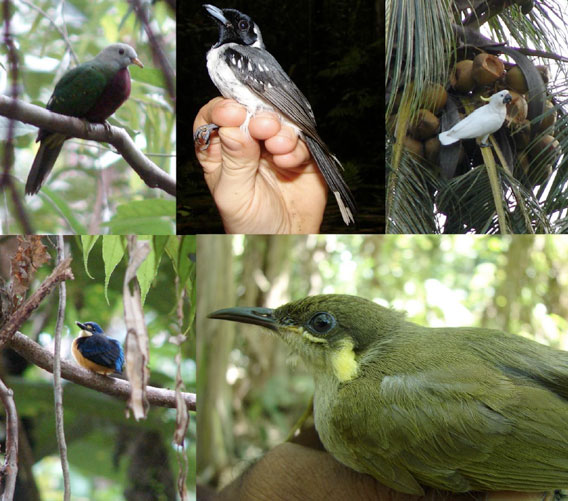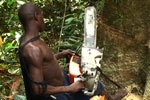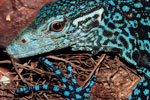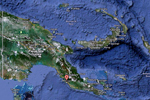A new survey recorded 125 birds in Papua New Guinea’s Waria Valley, of which an astounding 43 percent were endemic to the island. The survey, published in mongabay.com’s open-access journal Tropical Conservation Science, was the first of its kind for the rainforest-studded valley and found that bird populations were most diverse and abundant in primary forests.
The bird surveys were carried out in four different habitats including primary forest, primary forest edges, secondary forest edges, and agricultural landscape. According to the paper birds fared best in primary forest.
“Species richness and diversity were found to be greater in primary forest and primary edge habitats than in agricultural habitats, which supports findings from another lowland forest site in Madang” Papua New Guinea, the authors write. Interestingly the researchers however found little difference between bird communities in primary forests versus primary edge forests. Twenty-eight species recorded in the survey were only found in primary forest habitats, with frugivores (fruit-eating) largely dependent on forest cover for survival.
“Overall, our study has highlighted the importance of forested habitats to the avifauna, in that 49 of the total 125 species (39.2 percent) were recorded only in forested habitats (secondary, primary edge and primary), compared to just 11 species (8.8 percent) seen solely in agricultural habitats. It is highly likely that more species exist in the Waria Valley, particularly within the primary forest, as many species expected to be found in lowland rainforest in this part of New Guinea were not recorded,” the authors write.
They warn that population growth is leading to agricultural expansion leading to rising pressure on birds as well as other species. Industries, such as logging and mining, have not entered the valley as they have in other places in Papua New Guinea. The authors recommend more biodiversity surveys, education and awareness-building, and the creation of land-use management plans to conserve high biodiversity areas.

Clockwise from top left: Wompoo Fruit-dove (Ptilinopus magnificus), Spot-winged Monarch (Monarcha guttula), Sulphur-crested Cockatoo (Cacatua galerita) eating coconut, Graceful Honeyeater (Meliphaga gracilis cinerifrons), Variable Dwarf Kingfisher (Ceyx lepidus). Photos by J. Dawson.
CITATION: Dawson, J., Turner, C., Pileng, O., Farmer, A., McGary, C., Walsh, C., Tamblyn, A. and Yosi, C. 2011. Bird communities of the lower Waria Valley, Morobe Province, Papua New Guinea: a comparison between habitat types. Tropical Conservation Science Vol. 4(3):317-348.
Related articles
Big damage in Papua New Guinea: new film documents how industrial logging destroys lives

(08/29/2011) In one scene a young man, perhaps not long ago a boy, named Douglas stands shirtless and in shorts as he runs a chainsaw into a massive tropical tree. Prior to this we have already heard from an official how employees operating chainsaws must have a bevy of protective equipment as well as training, but in Papua New Guinea these are just words. The reality is this: Douglas straining to pull the chainsaw out of the tree as it begins to fall while his fellow employees flee the tumbling giant. The new film Bikpela Bagarap(‘Big Damage’) documents the impact of industrial logging on the lives of local people in Papua New Guinea.
Pictures: Turquoise ‘dragon’ among 1,000 new species discovered in New Guinea

(06/27/2011) Scientists discovered more than 1,000 previously unknown species during a decade of research in New Guinea, says a new report from WWF. While the majority of 1,060 species listed are plants and insects, the inventory includes 134 amphibians, 71 fish, 43 reptiles, 12 mammals, and 2 birds. Among the most notable finds: a woolly giant rat, an endemic subspecies of the silky cuscus, a snub-fin dolphin, a turquoise and black ‘dragon’ or monitor lizard, and an 8-foot (2.5-m) river shark.
Papua New Guinea suspends controversial grants of community forest lands to foreign corps

(05/06/2011) The government of Papua New Guinea yesterday suspended its controversial Special Agricultural and Business Leases program which has granted logging and plantation development concessions to mostly foreign corporations across 5.2 million hectares of community forest land, reports the Courier-Post